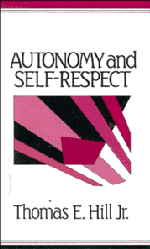Book contents
- Frontmatter
- Contents
- Sources and acknowledgments
- Introduction
- 1 Servility and self-respect
- 2 Self-respect reconsidered
- 3 Autonomy and benevolent lies
- 4 The importance of autonomy
- 5 Symbolic protest and calculated silence
- 6 Moral purity and the lesser evil
- 7 Self-regarding suicide: a modified Kantian view
- 8 Ideals of human excellence and preserving natural environments
- 9 Weakness of will and character
- 10 Promises to oneself
- 11 Social snobbery and human dignity
- 12 Pains and projects: justifying to oneself
- 13 The message of affirmative action
- Index
5 - Symbolic protest and calculated silence
Published online by Cambridge University Press: 05 June 2012
- Frontmatter
- Contents
- Sources and acknowledgments
- Introduction
- 1 Servility and self-respect
- 2 Self-respect reconsidered
- 3 Autonomy and benevolent lies
- 4 The importance of autonomy
- 5 Symbolic protest and calculated silence
- 6 Moral purity and the lesser evil
- 7 Self-regarding suicide: a modified Kantian view
- 8 Ideals of human excellence and preserving natural environments
- 9 Weakness of will and character
- 10 Promises to oneself
- 11 Social snobbery and human dignity
- 12 Pains and projects: justifying to oneself
- 13 The message of affirmative action
- Index
Summary
The reasons for protesting a serious injustice are usually not hard to find. One wants to put an end to the wrongdoing, to prevent its recurrence, or at least touch some consciences in a way that may prove beneficial in other contexts. But sometimes there seems to be no reasonable hope of achieving these ends. The perpetrators of injustice will not be moved, protest may be inconvenient or risky to oneself, and its long-range effects on others may be minimal or may include as much harm as help. To protest in these circumstances seems at best a symbolic gesture. But is it a gesture worth making? Attitudes about this diverge sharply. Some say that, despite the consequences, protest is called for: “One cannot stand silently by.” To denounce injustice at a risk to oneself is morally admirable, they say, whether or not it produces a positive net utility. Others see symbolic protest as pointless and at times reprehensible. If the overall effects for others are not better and it entails harm or risk to oneself, is it not foolish? And isn't the motive simply a self-righteous desire to be, or appear, morally “pure”?
These conflicting attitudes pose a problem of understanding for moral philosophy. The point of view behind the second attitude is clear enough: acts, including speech acts, are to be evaluated by their probable consequences; no one is morally required to take risks unless the probable consequences are beneficial; what is commendable is regard for the best results, not futile gestures.
- Type
- Chapter
- Information
- Autonomy and Self-Respect , pp. 52 - 66Publisher: Cambridge University PressPrint publication year: 1991



